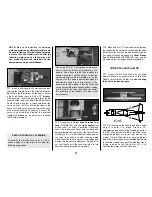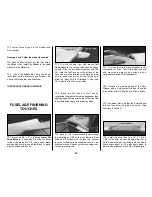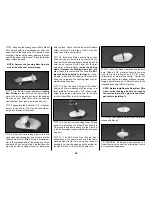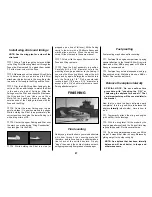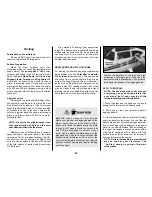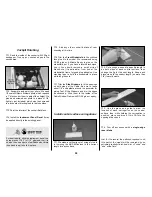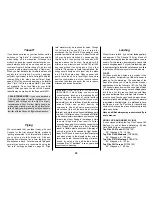
A FEW WORDS ABOUT
OPTIONAL LIGHTING
Scale lights make a model like this Cessna
come to life. We added a rotating beacon, dual
landing lights and position lights (see page 5 for
part numbers). The rotating beacon is powered by
a 9V transistor battery and a miniature circuit
board that allows you to vary the “rotation” speed.
The beacon and position lights are turned on via
a simple toggle switch hidden within the cowling.
The landing lights are powered directly from the
flight-pack battery and are plugged into the
receiver. By activating a sixth channel, we can
turn the lights on and off from the transmitter. You
could also “Y” the landing lights into the throttle or
flap servo so when either is operated, the lights
would come on.
Pockets built-in to the cowl greatly simplify
the installation of landing lights. The wiring was
modified to include a “Deans” connector and a
firewall-mounted plug so the cowling can be
removed without having to cut the wires.
The circuit boards and 9V batter y were
wrapped in foam rubber and installed under the
servo tray along with other electronic components.
❏
1. Epoxy the 5/16” x 3/4” x 7/8” hardwood
Servo Mounting Blocks
to the die-cut 1/16” ply
Flap and Aileron Servo Hatches
. Install the
Flap and Aileron servos as shown in the photo
and on the plans.
After “fishing” the servo wires
through to the opening at the center of the wing,
plug them into a “Y” har ness. Before
permanently screwing the servo hatches in
position, hook up your radio and set
centering
and
direction of both sets of servos.
❏
2. Drill 3/32” holes through the Servo Hatches
at each of the six punch marks. Position the
hatches in their respective openings, then drill
1/16” pilot holes into the
hatch support rails
.
Use
#2 x 3/8” flat head sheet metal screws
to
install the servo hatches.
❏
3. Install the Aileron Horns in line with the
pushrod exits as shown on the plans. Drill 1/16”
holes into the Ailerons at the proper hor n
locations. Screw the horns in place with
#2 x
3/8” sheet metal screws
.
NOTE: Put a couple of drops of thin CA
into each screw hole before reattaching
the horns.
❏
3. Four .074 x 4”
Threaded End Rods
are
supplied to make the
Flap and Aileron
pushrods
. Screw a nylon
Clevis
and silicone
Retainer
on each pushrod. The Flap pushrods
are connected to the ser vos using nylon
Faslinks
™
as shown in the photo. Aileron
pushrods are attached to the servos with
solder
clevises
. Hook up and adjust the Aileron and
Flap linkages. Refer to the
Control Surface
Throws
section for movement recommendations.
❏
4.
Permanently install
the Elevator (as
described on page
42
in
Steps 3 & 4)
and the
Rudder (page
43,
Steps
4 & 5
).
❏
1. Wrap the Receiver and Battery in 1/2” foam
rubber (Hobbico HCAQ1050) securing the foam
with rubber bands.
❏
2. Protect both components from fuel leakage
by sealing them in plastic wrap or plastic bags.
Seal the plastic closed with masking tape.
Install receiver, battery and antenna
Flap/aileron control hookup
FINAL HOOKUPS
AND CHECKS
51
Summary of Contents for CESSNA 182 SKYLANE
Page 8: ...8 DIE CUT PATTERNS ...

